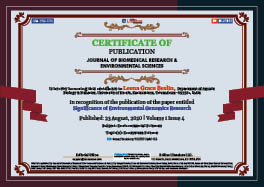Leena Grace Beslin*
Volume1-Issue4
Dates: Received: 2020-08-13 | Accepted: 2020-08-19 | Published: 2020-08-23
Pages: 103-104
Abstract
Environmental Genomics serves as a guide for an environmental scientist who wishes to squeeze genomics to solve environmental problems. Environmental genomics try to find out the approach of an organism or group of organisms to the changes in their external environment at the genetic level [1]. Since the genome responses are diverse, environmental genomics has the necessity integrate molecular biology, physiology, toxicology, ecology, systems biology, epidemiology and population genetics into an interdisciplinary research program [2].
FullText HTML
FullText PDF
DOI: 10.37871/jels1126
Certificate of Publication

Copyright
© 2020 Beslin LG. Distributed under Creative Commons CC-BY 4.0
How to cite this article
Beslin LG. Significance of Environmental Genomics Research. J Biomed Res Environ Sci. 2020 Aug 23; 1(4): 103-104. doi: 10.37871/jels1126, Article ID: JELS1126
Subject area(s)
University/Institute
References
- Aznar-Cormano L, Brisset J, Chan TY, Corbari L, Puillandre N, Utge J, et al. An improved taxonomic sampling is a necessary 1 but not sufficient condition for resolving inter-families relationships in Caridean decapods. Genetica. 2015; DOI: 10.1007/s10709-014-9807-0
- Baker M. Next-generation sequencing: Adjusting to data overload. Nat Methods. 2010; 7: 495-499. https://tinyurl.com/yybl52cs
- Ellegren H, Sheldon. Genetic basis of fitness differences in natural populations. Nature. 2008; 452: 169-175. DOI: 10.1038/nature06737
- Faure, Denis, Joly, Dominique. Insight on environmental genomics: The high-throughput sequencing revolution. Genetica. 2016; 143: 129-132.
- Graveley BR. Molecular biology: Power sequencing. Nature. 2008; 453: 1197-1198. DOI: 10.1038/4531197b
- Kruglyak L. The road to genome wide association studies. Nat Rev Genet. 2008; 9: 314-318. DOI: 10.1038/nrg2316.
- McKinney, Crowe JE, Guo J, Tian D. Capturing the spectrum of interaction effects in genetic association studies by simulated evaporative cooling network analysis. PLoS Genet. 2009; 5: e1000432. DOI: https://doi.org/10.1371/journal.pgen.1000432
- Noor MA, Feder JL. Speciation genetics: Evolving approaches. Nat Rev Genet. 2006; 7: 851-861. DOI: 10.1038/nrg1968
- Pompanon F, Samadi S. Next generation sequencing for characterizing biodiversity: Promises and challenges. Genetica. 2015; DOI: 10.1007/s10709-015-9816-7
- Robuchon M, Valero M, Gey D, Le Gall L. How does molecular-assisted identification affect our estimation of α,β and γ biodiversity? An example from understory red seaweeds (Rhodophyta) of Laminaria kelp forests in Brittany, France.Genetica. 2014; DOI: 10.1007/s10709-014-9796-z
- Rokas, Abbot P. Harnessing genomics for evolutionary insights. Trends Ecol Evol. 2009; 24: 192-200. DOI: 10.1016/j.tree.2008.11.004
- Turner, Hahn, MW Nuzhdin SV. Genomic islands of speciation in Anopheles gambiae. PLoS Biol. 2005; 3: e285. DOI: https://doi.org/10.1371/journal.pbio.0030285






























































